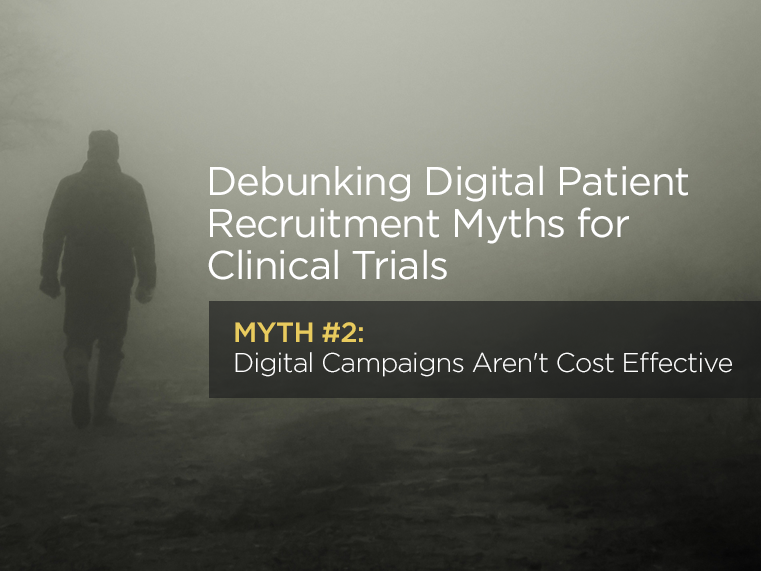
When it comes to clinical trial recruitment, fiction often rules the day. In this series, we debunk some of the most common misperceptions about digital recruitment for clinical trials, and set the record straight with hard facts and actionable solutions.

When it comes to clinical trial recruitment, fiction often rules the day. In this series, we debunk some of the most common misperceptions about digital recruitment for clinical trials, and set the record straight with hard facts and actionable solutions.
There’s a persistent myth among the clinical trial recruitment community that digital recruitment strategies, as innovative as they seem, aren’t worth the cost of investment. The reality couldn’t be farther from the truth.
Not only does digital recruitment enable CROs and trial sponsors to retain higher numbers of qualified patients at lower costs — we’ve documented as much as a 75% lower cost-per-acquisition (CPA) than traditional modes — it also grants them an unprecedented flexibility to tailor campaigns at a moment’s notice. That, combined with the demonstrated accuracy of digital targeting, makes digital marketing a highly valuable asset for any clinician.
“Digital campaigns aren’t cost-effective”
Today, 98% of all businesses are merging digital marketing with their traditional offline channels, and in 2015, an unprecedented 28% of the total U.S. advertising spend went towards digital. While idea of digital patient recruitment not being cost-effective may be widespread within the clinical trial space itself, it actually goes directly against broader market trends.
However, many are still hesitant to employ digital and social media marketing, despite the visible impact and value they’ve brought to companies in other industries — in fact, 89% of trials are NOT utilizing them at all. While some clinicians feel that these tools are still in their infancy, the reality is that they’re fully formed tactics that provide a variety of impactful benefits.
Key Advantages of Digital Ads
The chief benefit of digital recruitment strategies — search engine marketing (SEM), paid ads, and paid social campaigns, for example — is their targeting capabilities. Paid media platforms like Google Adwords and Facebook enable recruiters to reach high volumes of incredibly specific candidate segments, with high returns. Digital campaign click-through rates average between 0.1 to 5% per campaign; considering, for example, that there are 792,000 monthly searches for Alzheimer’s, it’s easy to see how digital can bring in thousands of qualified candidates to a trial website quickly and efficiently.
For trial sponsors, digital techniques are also incredibly low-risk. You can set up conditional, “try before you buy,” campaigns, wherein sponsors can start off small and test the efficacy of specific keywords, ad types, and locations — then quickly scale as soon as they’ve been optimized.
Digital campaigns can also be improved over time. By shifting marketing resources to the most effective locations, demographics, keywords, and channels (“over-65 knee osteoarthritis patients in Phoenix, AZ using Facebook”), sponsors can see improvements between 23-70% from their baseline in a few short months.
Tangible Returns
It’s not only that digital campaigns are more agile and accurate than traditional media — they also provide trial sponsors with demonstrable returns. For example, we were able to reduce a client’s clinical trial enrollment spend by a full 64%, simply by allocating more funds to digital.
Moreover, digital marketing contributes to cost-reductions at the trial itself. Recent data suggests that digital outreach programs and pre-qualifying can dramatically reduce on-site trial screening failure rates, from 80% to 30-40%, requiring fewer individuals to physically visit the site, ultimately bolstering enrollment and retention numbers as well.
Considering the tangible impact and return on digital marketing strategies, the notion that e-recruitment is less cost-effective than traditional channels is clearly an example of backwards thinking. We strongly recommend that clinicians take a look at the data on consumer preferences/habits, then seek out the latest tools and technologies needed to capitalize on these trends.